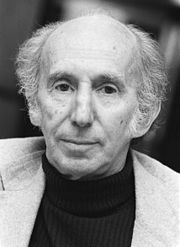Leo Vroman's Human Design Chart
6/2 Ego Projected ProjectorDutch-American hematologist, celebrated poet, painter and illustrator.
He was the son of Jewish parents: Samuel Jacob Vroman (4 Jan 1875, Rotterdam – 5 January 1942, Bussum) and Anna Mozes Vromen (5 June 1884, Zutphen – 1970 Israel). His brother Akiva Jaap Vroman (21 May 1912, Gouda – 1989, Herzliya) was an Israeli geologist.
Vroman visited the HBS in Gouda and studied biology in Utrecht (sept 1932). As a member of Unitas he met the writers Albert Alberts, Kees Stip and Anton Koolhaas and also engaged with Tineke Sanders, who he met in September 1938. When the Netherlands capitulated for the the Nazi’s (10 May 1940), Vroman decided to flee to England. On 14 May he en-shipped in Scheveningen. From England he travelled on 23 July 1940 to the Dutch Indies, where he looked for his fiancée Tineke. He would ultimately find her, but only after an odyssey of seven years.
He reached Batavia (7 August 1940) and could finish his biology study. But after Japan invaded the Dutch Indies, he became a prisoner of war. He stayed in camps in Tjimahi, near Bandoeng (Jan 1943), Tjilatjap, Batavia and Singapore. In 1943 he was shipped to Osaka, where he had forced labour in dry-docks. He got pneumonia and a Scottish POW saved his life by bringing him to hospital. During his stay in hospital, the barrack he previously stayed was destroyed by a fire bomb. Later he stayed in camps in Nagaoka, a city that was severely bombed by the USAF.
After his traumatic war experiences he reached Manilla. Here he heard that the Dutch government wanted to make a soldier of him, to combat the Indonesian freedom fighters. He decided to flee to the United States. Here he became a respected medical researcher and haematologist, noted for the discovery of the Vroman effect in blood coagulation.
On 10 September 1947 he married the anthropologist Georgina-Maria Tineke Sanders (14 March 1921, Batavia)in New Jersey. They got two daughthers: Geraldine (6 July 1950) en Peggy Ann (1952). In 1952 he worked at the Mount Sinai Hospital. Later at the Department of Animal Behaviour of the American Museum of Natural History in New York and the Veterans Administration Hospital in Brooklyn.
Although Vroman considered himself a s scientist in the first place, he received major Dutch literary prizes for his poetry, including the Lucy B. and CW van der Hoogt Prize (1950) and received on 24 May 1965 the PC Hooft Prize of 1964 for his entire work.
He died 22 February 2014 in Fort Worth (Dutch: Fort Waarde).
Link to Wikipedia
Discover More Famous People
Browse and analyze over 55,000 public figures and celebrities.
Ra Uru Hu
5/1 Manifestor
Martha Stewart
4/6 Manifestor
David Lynch
4/6 Generator
Barack Obama
6/2 Projector
Steve Jobs
6/3 Generator
Vladimir Putin
5/1 Manifestor
Kim Kardashian
3/5 Generator
Michael Jackson
1/3 Projector
Marilyn Monroe
6/2 Projector
Ariana Grande
2/4 Projector
Oprah Winfrey
2/4 Generator
Johnny Depp
2/4 ManifestorWhat is HumanDesign.ai and how does it work?
Curious what makes Leo Vroman tick? HumanDesign.ai instantly maps their exact birth data into a fully interactive clickable bodygraph chart, letting you hover or tap every center, channel, and gate for plain-language explanations. Bella, the platform’s built-in AI guide, adds context in real time, translating complex mechanics into everyday insights so you can see how Leo Vroman’s strengths, challenges, and life themes play out on-screen.
The same tools are waiting for you. Generate your own Human Design Chart in seconds, open a library of 2000+ suggested questions, and chat with Bella as often as you like to decode your design, daily transits, and even relationship dynamics.
Want to compare energies? Save unlimited charts for friends, family, or clients, then ask Bella to reveal compatibilities, composite patterns, or coaching tips, all in one conversation thread.
Start free with core features, or unlock our Personal and Pro plans for deeper dives: unlimited Q&A, celebrity chart search spanning 55,000+ public figures, white-label PDF reports, branded content generation, and a professional profile with built-in booking for practitioners. Whether you’re exploring your own potential or guiding others, HumanDesign.ai delivers an ever-expanding toolbox of AI-powered insights—no spreadsheets, no jargon, just clarity at your fingertips.
Ready to see yours? Signup for FREE today!

